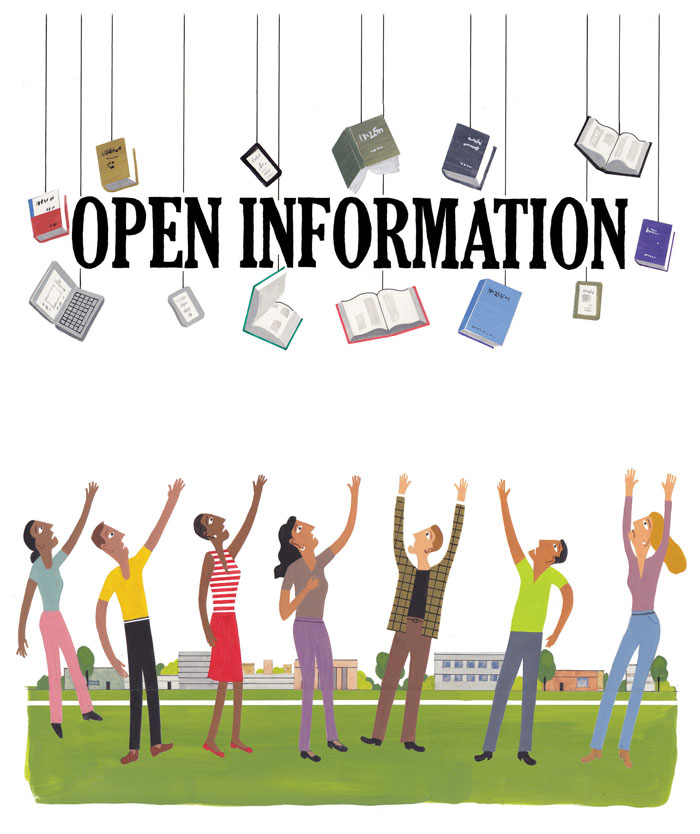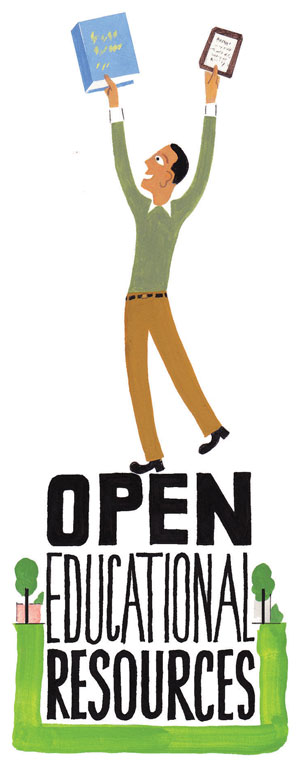The Other Open-Access Debate
By David Harris, Mark Allen Schneegurt
Alternative educational resources need to be further developed to counteract an increasingly costly textbook burden on university students.
Alternative educational resources need to be further developed to counteract an increasingly costly textbook burden on university students.

DOI: 10.1511/2016.123.334
On the first day of class for a semester, a professor goes through the traditional ritual of discussing the syllabus. The professor tells the students about the expectations for the course, reviews the schedule of lectures, and talks about the policies for testing and attendance. Then the professor points out the required textbook for the course, which prompts audible groans. Several students ask whether the textbook will be used heavily, with specific assignments from the back of the chapters. When the instructor says that it is more of a reference volume for reading and studying, the groans get louder. Students have realized that the textbook is going to add a great deal of cost to their course, perhaps half again the cost of tuition. Many will decide to take a chance by using older, less expensive editions of the book, and many will choose to take a course without owning the textbook at all. Clearly, this scenario does not promote student success, and it creates an immediate barrier between students and faculty.

The cost disconnect between professors and students has some concrete origins. In a 2014 Planet Money show on National Public Radio, professors interviewed said that textbook salespeople often described to them the advantages of a new edition, but without ever discussing the book’s price, meaning that in some cases professors were selecting textbooks without any idea of the cost to students. This scenario is supported by a 2008 report from the California State Auditor on the affordability of college textbooks, which came to the following conclusion: “Nearly all of the faculty members we interviewed were unaware of state laws encouraging them to participate in efforts to reduce textbook costs and many did not understand how their decisions and priorities when selecting a textbook could affect student costs.” In addition, a 2007 report to Congress from the Advisory Committee on Student Financial Assistance recognized the need to restructure the publishing market and make it more “student-centric.” Encouragingly, a 2013 U.S. Government Accountability Report on student access to textbook information noted that faculty interviewed “said they are more aware of affordability issues than they used to be.”
But even when professors are aware of the burden of textbook costs for students, they can face institutional pushback when looking for less expensive options. For example, in late 2015 a mathematics associate professor at California State University at Fullerton challenged a reprimand that could damage his application for full professorship; he was reprimanded after he defended his introduction of a free, alternate text for his students over the standard book that cost $180—which was authored by the department chair and vice-chair. The incident is still causing controversy.
We may look back on this period and conclude that quality open educational resources went mainstream, not because it was free of cost, but for the freedoms it provided learners.
The debate about the cost of textbooks is part of a wider discussion about academic publishing in general, particularly in relation to research papers that are published only behind a journal’s paywall. Advocates for the open-access movement, as it is called, argue that the results of research conducted using public funds should be freely accessible to everyone. Journals such as the ones produced by Public Library of Science (PLOS) were created with this mandate in mind (however, the researcher or institution usually bears the production costs, which many try to cover with grant funding). With the National Institutes of Health leading the way, funding agencies are requiring awardees to make their research publications available to the public for free. Self-assembling repositories such as ResearchGate are disrupting traditional dissemination patterns by allowing researchers to publicly post their research publications themselves.
Similarly, the knowledge that students are expected to learn in introductory science, technology, engineering, and mathematics (STEM) courses is based on publicly funded research that goes back generations. It seems wildly unfair to charge the next generation outrageous prices for information that is so established and well trodden. But alternatives can be found in open educational resources (OER), which include textbooks as well as other digital reference and teaching materials. These resources are distributed with an open license, tearing down barriers to broad access.
The problem of textbook cost has become so pervasive that in October 2015 the U.S. Senate Committee on Health, Education, Labor, and Pensions introduced called the Affordable College Textbook Act. This legislation states that “Federal investment in expanding the use of open educational resources could significantly lower college textbook costs and reduce financial barriers to higher education, while making efficient use of taxpayer funds.”
In 2013 Forbes.com published a feature titled “How the $1.2 trillion college debt crisis is crippling students, parents, and the economy.” In it, 7 out of 10 students were reported to be borrowers, graduating with an average of more than $25,000 in debt—a figure that goes up year after year. Books are a significant part of that debt, particularly for low-income students attending public universities. The website Cengagebrain.com shows that STEM textbooks frequently carry list prices of more than $250, putting them out of reach for many students. An NBC News review of Bureau of Labor Statistics data in 2015 found that textbook prices rose at more than three times the rate of inflation from January 1977 to June 2015, a 1,041 percent increase. At the same time, the lifetime cost of not completing two- and four-year degrees is also on the rise: Students without a college degree experience lower earnings, higher debt, and an increased likelihood that they will not break the cycle of poverty. These students are indeed too broke to fail.
According to Covering the Cost, a report by the U.S. Public Interest Research Group (USPIRG), as of January 2016, the average college student would need to work nearly 28 hours at a minimum wage job to pay for just one $200 textbook. Books can account for 40 percent of academic costs at community colleges. In addition, a 2014 study by the nonprofit National Student Clearinghouse found that students who are enrolled only part time in classes (often because they need to work to cover costs) drop out at a rate of 68 percent, compared to 19 percent for full-time students. This situation has created an ethical imperative to rapidly increase access to open educational resources, which are generally distributed free of charge, thus solving major financial and access hurdles.
The mainstreaming of OER is coinciding with advances in technologies designed to improve access for students with disabilities. OER are more frequently available in more formats than traditional textbooks, and across various devices, to better serve populations with disabilities. An example of this development is Bookshare.org, an online library of more than 470,000 titles in formats accessible for people with print disabilities, developed by the nonprofit Benetech.
Current digital rights management (DRM) restrictions on traditional textbook or supplemental materials come from an era of “unidirectional” information flow and control. DRM limits access to a discrete period of time, limits the number of pages that can be printed, limits the number of devices on which content can be accessed, and limits the sharing of information. Fortunately, learners today have grown up with cloud computing, where the opportunity to network, access information, and share knowledge is limitless. Access at any time, in any format, across multiple devices, along with the ability to share content, provides a level of freedom that is igniting innovation and lasting change across the market. We may look back on this period and conclude that quality OER went mainstream, not because they are free of cost, but because of the freedoms that OER provided learners. These new resources are leveling the playing field and opening the gates to student success.
Free textbooks encourage usage, but only a material’s quality fosters learning. Open education resources are typically published by nonprofit education entities that have missions much better aligned with those of scientific societies than with those of traditional publishers. This alignment presents opportunities for collaboration to explore new ideas and provide enhanced pathways for peer review and the community contributions that engender credibility. For example, in our OpenStax Microbiology textbook, we worked with Sigma Xi to include vetted perspectives on ethics in science.

Many providers are examining methods to ensure that OER undergo the equivalent evaluations that traditional textbooks receive. For instance, the proposed Affordable College Textbook Act calls for a system of grants to be set up that could be used not only to produce new OER, but also to evaluate their quality, and to research the student learning outcomes they produce. Indeed, this legislation addresses the need for academics who spend their time creating OER to be compensated, as does the 2008 California Auditor Report, which noted that one university chancellor “stated that open educational resources cannot be successful unless contributions from faculty and reviewers are supported through existing sabbatical and professional growth programs or specifically compensated if state funding becomes available in the future.” Going digital could reduce some overhead costs of textbook production as well. A 2008 study by the National Association of College Stores reported that publishers had provided information that broke down textbook costs as follows: “around 15.4 cents of every dollar went toward marketing the textbooks, 11.7 cents went to the authors, and 32.2 cents went to paper, printing, and paying publishers’ employees.”
The STEM community has an often touted reputation of being resistant to change, but faculty members are embracing the freedoms of going open source. According to a July 2016 Babson College Survey, in introductory courses with large enrollments, the rate of adoption of openly licensed OpenStax College textbooks is 10 percent, compared with a rate of 5.3 percent in all courses. OpenStax is only one of the bourgeoning number of OER providers, so rather than resisting change, the academic community must be applauded for embracing and advocating change. Some universities, such as the University of Minnesota and the University System of Maryland, maintain libraries of open-access textbooks, to make them easier for faculty to find and implement in their courses.
The way we share information with the next generation is changing. We want our students to succeed. Forcing subsequent generations to pay substantial sums to access well-established, publicly generated knowledge works against our societal goals. Open-source textbooks will allow more students to go to college, be successful, and become productive professionals. OER are changing the education equation for students and faculty, with society on the winning end.
Click "American Scientist" to access home page
American Scientist Comments and Discussion
To discuss our articles or comment on them, please share them and tag American Scientist on social media platforms. Here are links to our profiles on Twitter, Facebook, and LinkedIn.
If we re-share your post, we will moderate comments/discussion following our comments policy.